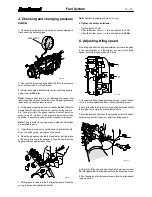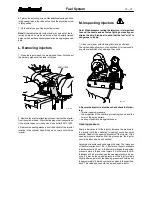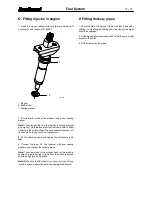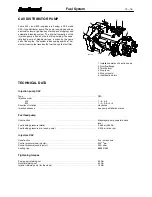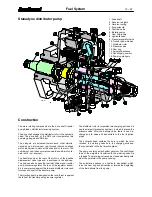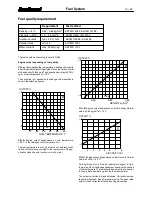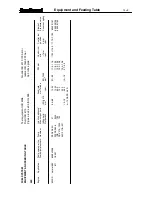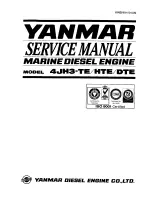
213--- 42
Fuel System
13---23
Stanadyne distributor pump
Housing pressure
Transfer pump pressure
Injection pressure
1. Fuel tank
10. Regulator spring
2. Water trap
11. Centrifugal weights
3. Fuel feed pump
12. Overflow valve
4. Fuel filter
13. Hydraulic head connecting passage
5. Transfer pump
14. Metering valve
6. Pressure regulator valve
15. Hydraulic head charging pasage
7. Automatic advance
16. Distributor rotor
8. Air vent passage
17. Pressure valve
9. Stop solenoid
18. Injector
Function
The fuel feed pump draws fuel from the tank via the water
trap and the filter into the fuel injection pump.
In the pump fuel flows through the inlet filter screen into the
vane type fuel transfer pump. Some fuel is bypassed through
the pressure regulator assembly to the suction side.
Fuel under transfer pump pressure (1---6 bar) flows through
the center of the transfer pump into the circular groove on
the rotor. It then flows through a connecting passage in the
head to the automatic advance and up through a radial
passage and then through a connecting passage to the
metering valve. The metering valve adjusts amount of
injected fuel and position of the metering valve is con-
trolled by the governor (revolution lever) and the stop sole-
noid. From the metering valve fuel flows to the radial charg-
ing passage and further to the head charging ports.
As the rotor revolves, the two rotor inlet passages register
with the charging ports in the hydraulic head, allowing fuel
to flow into the pumping chamber. With further rotation, the
inlet passages close and the port to the injectors opens.
While the discharge post is opened, the rollers contact the
cam lobes forcing the plungers together. Fuel trapped
between the plungers is then pressurised and delivered by
the nozzle to the combustion chamber.
The injection pump is self---lubricating, and it has not been
connected to the engine lubrication system.
As fuel at transfer pump pressure reaches the charging
ports, slots on the rotor shank allow fuel and any entrapped
air to flow into the pump housing cavity. In addition, an air
vent passage in the hydraulic head connects the outlet side
of the transfer pump with the pump housing. This allows air
and some fuel to be bled back to the fuel tank via the over-
flow valve.
The fuel thus bypassed fills the housing, lubricates the
internal components, cools and carries off any small air
bubbles. The pump operates with the housing completely
full of fuel; there are no dead air spaces anywhere within
the pump.




